The journey to make my VW GTI hold absurd cornering speed and feel great while doing it has led me to neglect engine mods a little bit. I did the typical stuff; intake and a stage one tune with a Fluidampr and some odds and ends. But I didn’t really add cooling for the extra 100 lb-ft of torque and 60 HP increase from the tune. I decided that it was finally time to tackle an external oil cooler install.
I decided this after experiencing some high oil temps and subsequent low pressures from extended sessions at the track, and uphill canyon runs in 95-degree ambient heat. I also didn’t have an oil temp gauge so I relied on the raw coolant readout from another mod I installed to make sure I wasn’t cooking anything too badly. This might sound nonsensical, but most modern cars have a water-cooled oil cooler or a water-to-oil cooler.
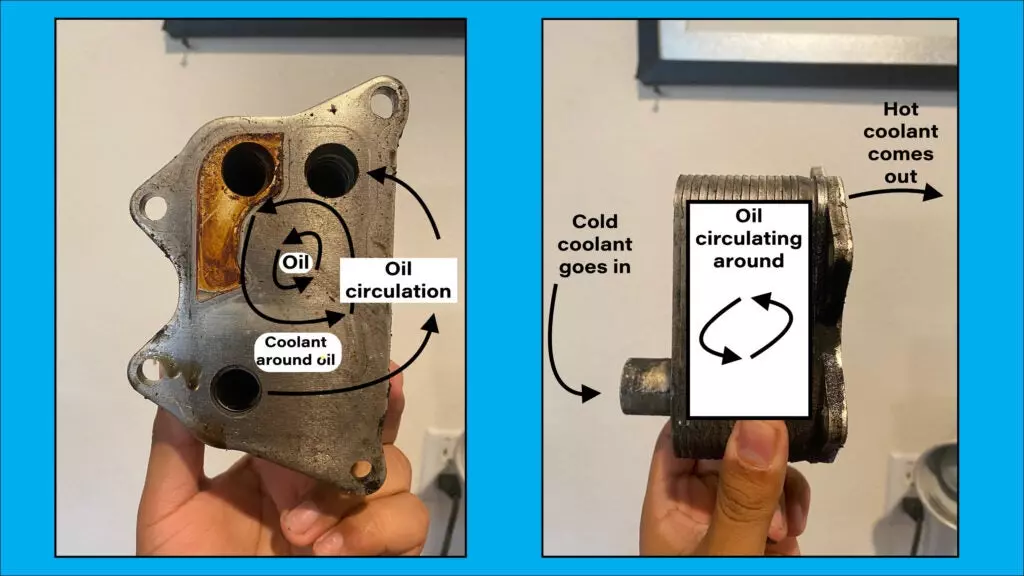
Basically, it’s a small matrix of engine coolant that surrounds another matrix of oil, usually mounted close to or directly on the oil filter housing. There are pros and cons to this setup. A huge pro is that oil comes up to temperature quickly because as the coolant warms up, the oil also absorbs that heat and warms up. There is a huge con too, however, and it’s that this cooler has very little cooling capacity once things start warming up. It will keep oil and coolant temps similar under normal driving, but on the track, oil temps will skyrocket and keep going.
The reason for this is because the coolant is ultimately very hot and getting hotter, usually around 200-210 degrees for most cars. When oil temps get up into the 250 and 260-degree range, it’s putting real heat back into the coolant and bringing the temperature of the coolant up with it. That’s a huge problem.
To cool a system effectively, you need a sufficient negative difference between the temperature of fluid that’s coming out and the temperature of what’s going back in. So if the oil is at 250 degrees and the coolant is climbing up 220 and 230, there’s barely 20 degrees of difference keeping everything in check. That coolant/oil matrix that I mentioned earlier is basically another type of a radiator. So for another example, my coolant temps have been getting higher because of the load from the hot oil, and this leads to heat soak in my normal cooling system too.
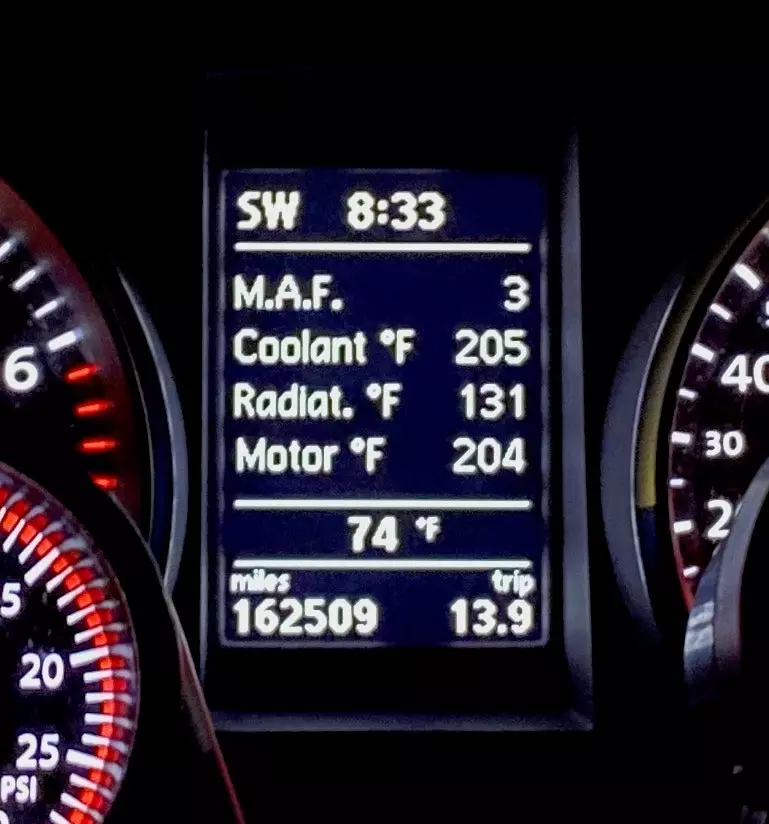
With my nifty PolarFIS, I can actually see in real-time my coolant expansion tank temperature, my engine coolant outlet temperature, and my radiator temperature. With those three data points, I can see how much cooling capacity I have left before I have to back off or if I can keep pushing in a track session. The GTI aims for 200-degree coolant temps for the expansion tank and engine outlet, and the radiator settles around 140 degrees in normal driving. That 60-degree difference is a healthy margin for a lot of cooling.
Once I start driving the car hard and get a few hot laps in, my coolant is steady at 200-210 degrees, but the radiator temperature climbs until it’s within 5-10 degrees of the coolant temperature. When that happens, the coolant temps start to rise. That is called heat soak, which is when the cooling system has no ability to cool itself with current operating conditions and will continue rising in temperature.
That difference in fluid temperature is the most important part of cooling a car, making sure that the coolant or oil coming out of the radiator is much colder than the stuff going in. Got it? Cool.
So my oil cooler would quickly get heat soaked and cause extremely high oil temps over very short track sessions, putting my engine in danger. With temperatures over 270 degrees, you can start breaking the oil down and reducing its capacity to lubricate and protect the engine, which is very bad. I didn’t have an oil temp gauge as I said before, and I relied on coolant temp and audible cues to save the car. I couldn’t keep doing this to the poor GTI, so I bought a kit from a kind guy on Facebook who was parting out his track-spec VW Jetta GLI.
Actually putting the kit together for my car is more expensive, harder to find, and difficult to install compared to many other cars. Most machines you’ll see, especially Japanese and American cars, will use a simple sandwich plate under the oil filter to hijack the oil flow and send oil to your external cooler. It’s also pretty simple on those cars to delete the factory oil cooler so it isn’t linked to coolant temp anymore.
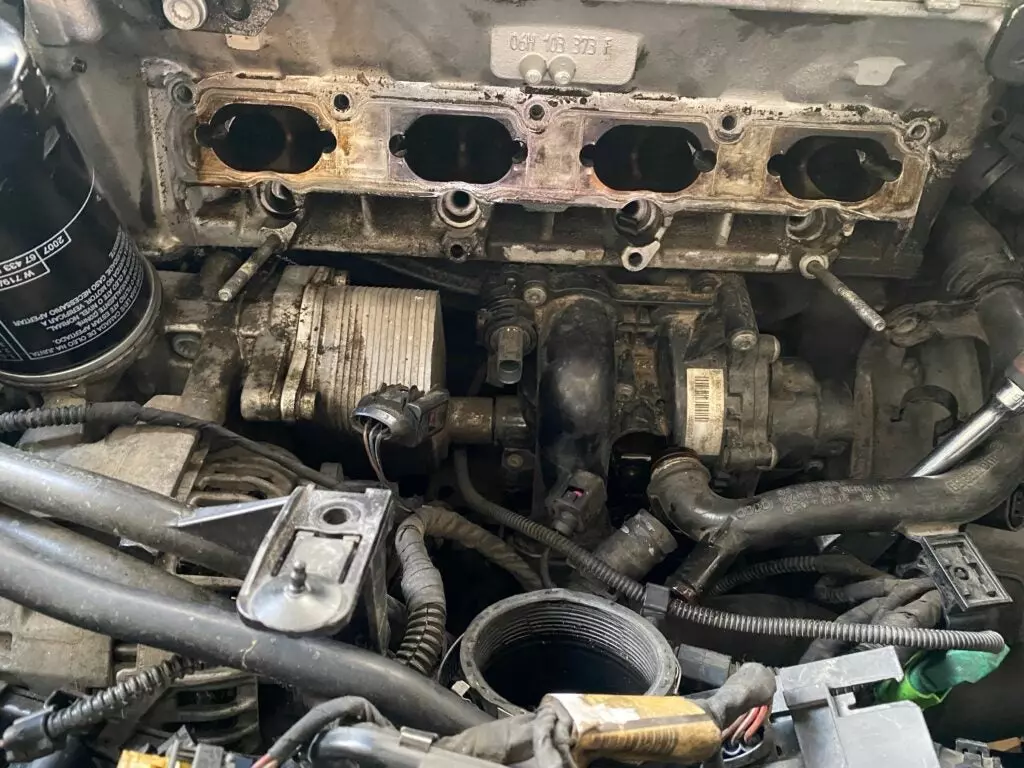
My car hides the cooler underneath the intake manifold, it’s linked to the water pump, and I can’t fit a sandwich plate under my oil filter. So I needed some extra parts: an iABED oil cooler delete plate to replace the factory cooler and a special banjo end on an AN line. Luckily, the used kit I bought had those harder-to-find parts, so all I had to worry about was mocking it up and modifying the lines to fit the GTI.
I got the entire used kit for $450, considering that the iABED plate was $250 on its own and that braided AN lines are expensive as hell, I consider that pretty fair. It was going to be a medium-sized project, so before I committed to removing the intake manifold I took the front bumper off and started mocking up where I would mount the cooler and route the lines, making sure that the lines I had were long enough for the different style of the GTI front end.
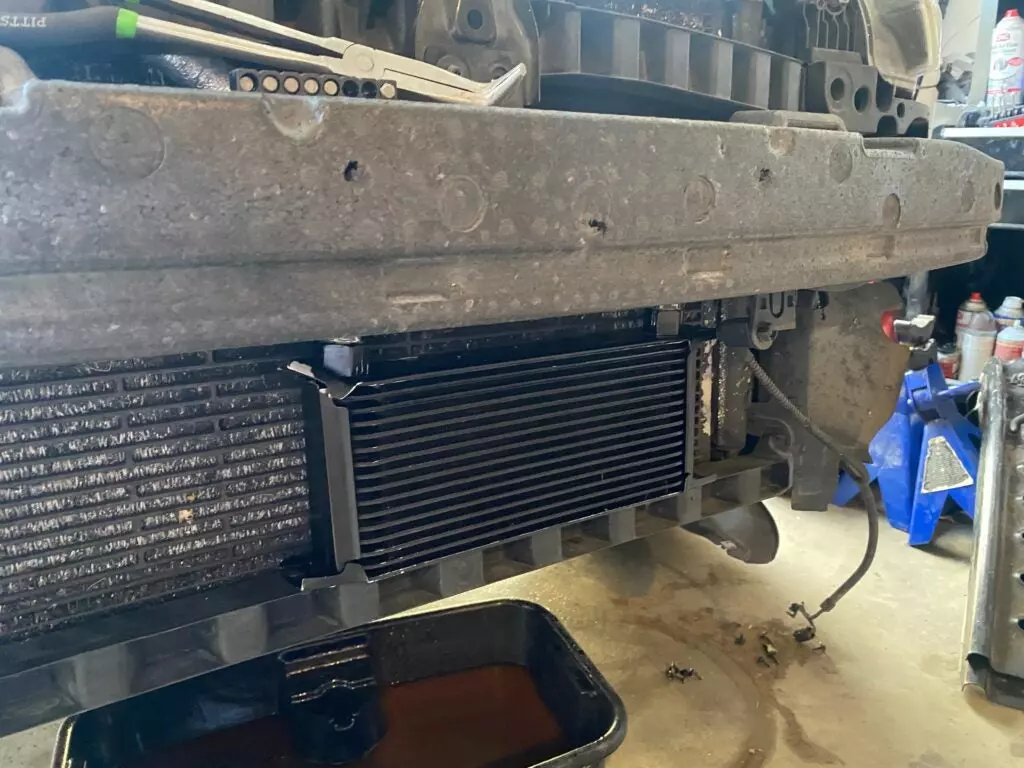
The dude I bought it from deleted the bumper bar of the GLI and mounted it high up, where I wanted to keep the GTI factory safe so I had to mount it at the very bottom of the front end where it would get the airflow it needed. I was worried that my lines wouldn’t be long enough, and my suspicions were correct; one of the oil thermostat to cooler lines was much too short.
Luckily, because the kit came with a thermostat, I could get some off-the-shelf stuff from a local supplier. It would’ve been much worse if it was the banjo-style feed line from the iABED plate, which was specialized and hard to get. $100 later for a new hose and a variety of extra AN bends to make my install easier, I got the cooler mocked up and ready to go.
With that, I spent the money on a new water pump to install because I was removing the old, unknown one anyways. These cars are notorious for breaking pumps so I seized a preventative opportunity and also hoped it would stabilize my coolant temps a bit more. I went for a genuine plastic/metal water pump instead of the aftermarket full metal pump. The factory pump is precisely designed to expand and contract with the material of the engine block, where the aftermarket metal one is just an aluminum mold of the plastic pump, with unknown research and development put into it.
I’ve had the intake manifold off several times so I had it out in about 20 minutes, while I struggled with the mess of lines underneath to successfully unhook the coolant hoses and remove the water pump. I found a nasty surprise; green coolant. I had been putting the normal nuclear pink-colored G13 coolant which doesn’t mix well with green. I had to address that soon.
With the pump off, I could remove the oil cooler with a triple square bit and creative usage of a U-joint. I didn’t realize that there was a gasket for the cooler, but the old gasket was serviceable and I reused it for the install. I know that’s not always proper protocol, but whatever.
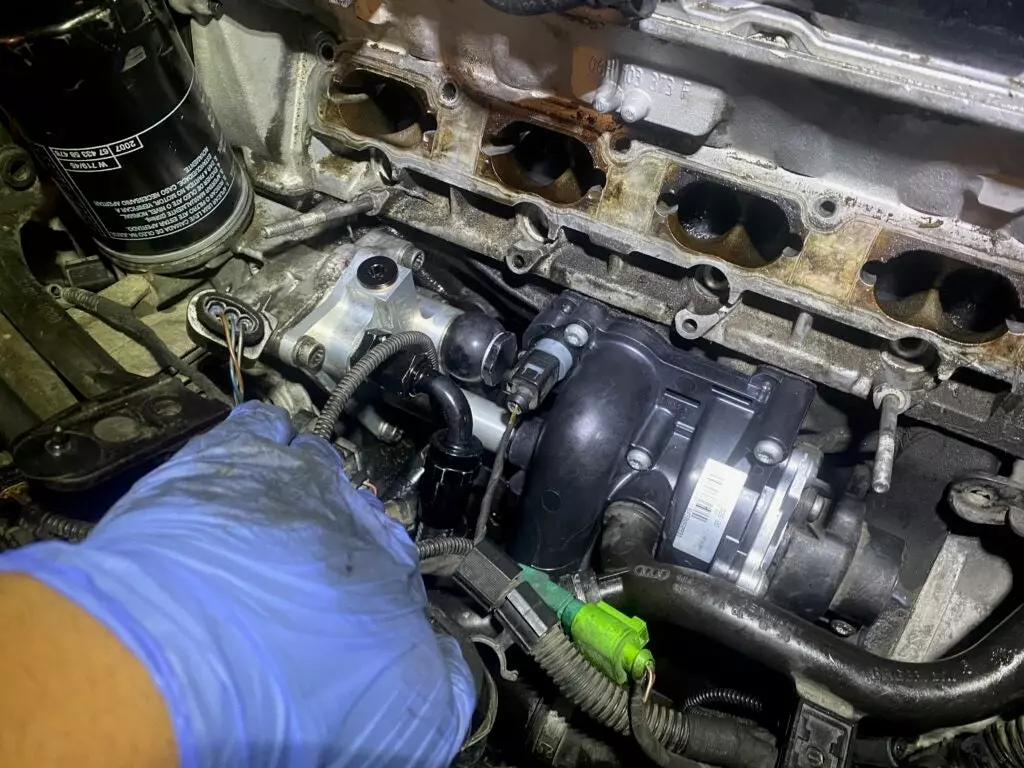
With that squared away, I installed the new water pump by first putting the funny little coolant union piece into the pump and then matching it up with the protruding tube from the oil cooler plate. The water pump bolted down tight, I clicked the coolant hoses back into place. I could finally install the AN lines to the cooler plate.
I routed it underneath the alternator and back up to the thermostat which I mounted just above the radiator. There was a useful hole to run the lines down to the oil cooler itself, and that made a clean install. I installed my new-old-stock Defi Red Racer 100-300 degree temperature gauge with a nifty AN extension piece and 1/8PT adapter into the hot side oil line, finally adding a layer of monitoring I desperately needed to keep the car healthy. It was coming together!
With everything verified tight and plenty of Teflon tape used to seal things, I buttoned the car back up, fired it up, and took it for a test drive. This ended up being the perfect install with zero hiccups afterward and flawless operation. Yes, I was very proud of myself.
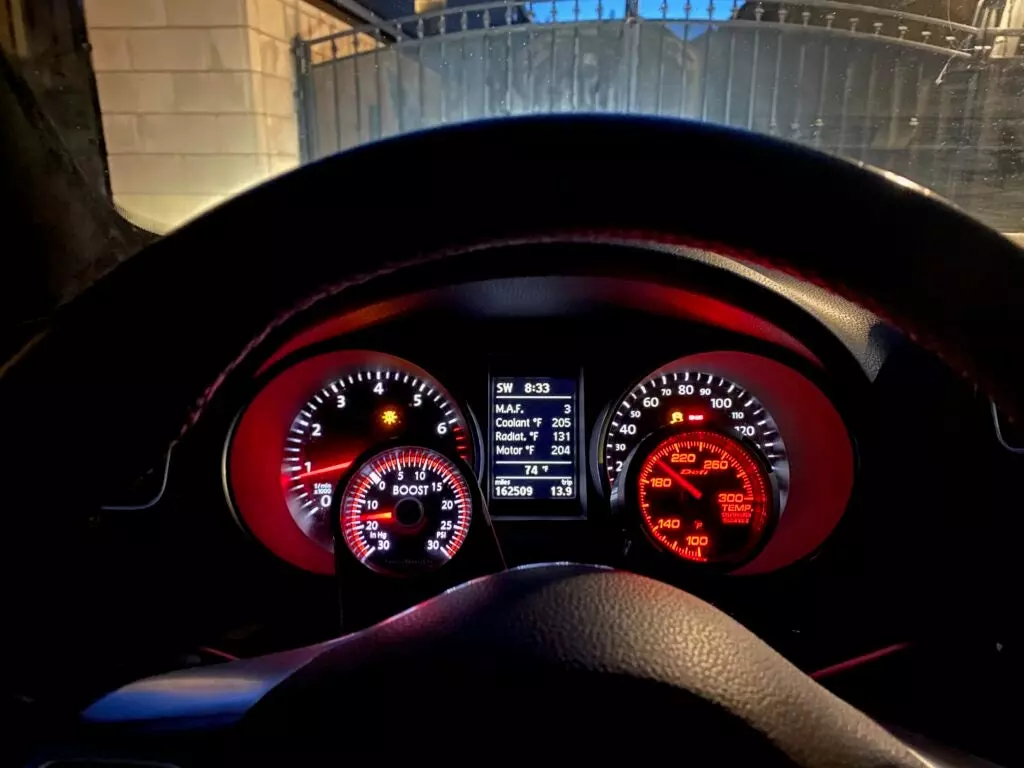
Immediately, the car settled on a nice 220 degree cruising oil temperature on 100 degree ambient days, and the thermostat kept stuff around 200 on colder days. On hard-driving, it kept oil temps at 250 all session until some of my hottest 110+ degree ambient track days where the car was just overwhelmed with no fault of the setup.
This has been the greatest peace of mind mod I’ve ever done. Not only can I monitor and manage my car’s temperatures with great accuracy now, but it also keeps itself cold and steady for long sessions where it would get very hot previously. At the very least, I should’ve figured out an oil temperature gauge quicker but this is great.
Onto more track days and skids with the GTI!









